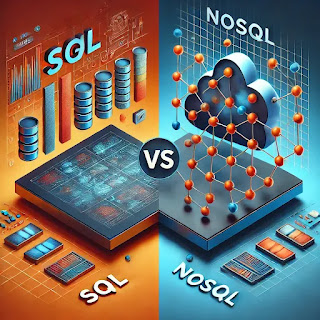Introduction
Databases form the backbone of modern applications, from small websites to enterprise-level systems. The choice of a database—whether SQL or NoSQL—can significantly impact your application's performance, scalability, and maintenance. The debate over SQL (Structured Query Language) versus NoSQL databases has been ongoing for years, with each type offering distinct advantages and use cases.
In this blog, we’ll explore the key differences between SQL and NoSQL databases, their strengths, and when to choose one over the other.
What Are SQL Databases?
SQL databases, also known as relational databases, organize data into structured tables with rows and columns, similar to a spreadsheet. Each table has a predefined schema, ensuring consistency in the type and format of data stored. Popular SQL databases include:
- MySQL
- PostgreSQL
- Oracle Database
- Microsoft SQL Server
These databases are optimized for structured data and complex queries, making them the industry standard for many applications.
Key Features of SQL Databases:
- Structured Data: Relational databases are ideal for storing data with clear relationships.
- ACID Compliance: Transactions follow the principles of Atomicity, Consistency, Isolation, and Durability, ensuring reliable operations.
- Relational Model: SQL databases use foreign keys and joins to establish relationships between tables.
What Are NoSQL Databases?
NoSQL databases, or non-relational databases, offer a more flexible approach to data storage. Instead of a fixed schema, NoSQL databases handle a variety of data models, such as key-value pairs, documents, graphs, or wide-columns. Popular NoSQL databases include:
- MongoDB (document-based)
- Cassandra (wide-column store)
- Redis (key-value store)
- Neo4j (graph database)
These databases excel in handling unstructured or semi-structured data, offering horizontal scalability and high performance.
Key Features of NoSQL Databases:
- Flexible Schema: NoSQL databases can adapt to changing data requirements.
- High Scalability: Designed to scale horizontally across multiple servers.
- Data Model Diversity: Supports various data formats, including JSON, XML, and binary.
Key Differences Between SQL and NoSQL
| Aspect | SQL | NoSQL |
|---|---|---|
| Data Model | Relational (tables) | Non-relational (key-value, etc.) |
| Schema | Fixed | Flexible or schema-less |
| Scalability | Vertical | Horizontal |
| ACID Compliance | Fully ACID-compliant | May prioritize eventual consistency |
| Query Language | Structured Query Language (SQL) | Varies by database (e.g., APIs, JSON-based queries) |
When to Use SQL Databases
SQL databases are ideal for scenarios requiring structured data and complex relationships. Some typical use cases include:
- Financial Systems: Require precise and consistent transactional data.
- Inventory Management: Benefit from structured, relationship-based schemas.
- Enterprise Resource Planning (ERP): Where data integrity is critical.
SQL databases shine when data consistency, complex querying, and multi-table joins are necessary.
When to Use NoSQL Databases
NoSQL databases are better suited for projects with large, diverse, or rapidly changing datasets. Typical use cases include:
- Real-Time Applications: Like social media platforms or gaming systems.
- Content Management: Flexible schema adapts to changing data requirements.
- IoT and Big Data: Handles high-volume, unstructured data efficiently.
Choose NoSQL for projects where scalability, high-speed operations, or flexibility are paramount.
Advantages and Disadvantages
Advantages of SQL
- Proven and mature technology with robust community support.
- Highly reliable due to strict schema enforcement and ACID compliance.
- Efficient for complex querying and reporting.
Disadvantages of SQL
- Limited scalability due to reliance on vertical scaling.
- Less flexible when dealing with unstructured or rapidly evolving data.
Advantages of NoSQL
- Highly scalable and designed for distributed architectures.
- Accommodates a variety of data formats.
- Fast read/write operations for high-volume applications.
Disadvantages of NoSQL
- May lack support for complex queries or joins.
- Requires extra effort for data consistency in some scenarios.
- Fewer standardized tools compared to SQL databases.
How to Choose Between SQL and NoSQL
The choice between SQL and NoSQL databases depends on your specific needs. Consider these factors:
- Data Structure: SQL is ideal for structured, relationship-based data. NoSQL excels with unstructured or semi-structured data.
- Scalability: SQL works best for vertical scaling, while NoSQL handles horizontal scaling more effectively.
- Use Case: SQL suits applications requiring high data consistency. NoSQL is better for real-time, high-traffic, or big data applications.
- Development Speed: NoSQL’s schema flexibility can accelerate development for rapidly changing projects.
Real-World Examples
SQL in Action:
A retail company uses MySQL to manage inventory, sales, and customer data. The structured nature of SQL ensures consistency across the system, enabling efficient reporting and data analysis.
NoSQL in Action:
A social media platform relies on MongoDB to store user profiles, posts, and interactions. The document-based model allows rapid changes to user features without altering the entire schema.
Conclusion
Both SQL and NoSQL databases play essential roles in modern software development. SQL databases provide a robust foundation for applications requiring structured data and consistency, while NoSQL databases offer unmatched flexibility and scalability for unstructured or rapidly evolving data.
Choosing the right database depends on your project’s requirements. By understanding the strengths and limitations of each type, you can make an informed decision and set your application up for success.
Which type of database have you used in your projects? Share your experiences in the comments below!
Happy coding! 🎉

Comments
Post a Comment